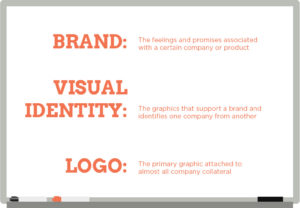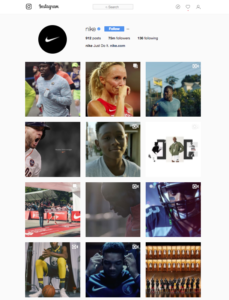Branding, Identity, and Logos
No doubt you’ve come across these three buzzwords in the business world, but what are they and how do they impact your company? Whether you’re a start-up currently scouring the Internet to find a logo designer, or you’ve come to realize your company needs another go at branding, it’s vital to understand these three words and how they work together to help your business grow. In this post, we’ll cover the basic definition these terms, and then delve into the first one.
So first, a simple definition.

The common misunderstanding surrounding these terms can lead to confusion and misdirection within a company, as well as stifle communication between a company and their designer. Let’s delve a little deeper into each term so we can walk away with a clearer understanding of the world of “branding.”
The confusion begins with the interchanging usage of “logo” and “brand.” This stems from the origin of the term “brand.” In the old days, ranchers and farmers would brand their livestock with an image to distinguish their herds from others. That image became associated with the farmer, much like the Golden Arches has become synonymous with McDonald’s. This was the beginning of logo design. But since then, branding has evolved into a different form. A brand is no longer a single image; the term “logo” takes that definition. Instead, a brand has become an intangible entity.
RELATED POST: Three Steps To Improve Your Branding Right Now
Take Nike for example. In addition to having one of the most recognizable logos, it’s become the poster child for branding. It causes us to ask how is this company able to charge such enormous prices for athletic wear? Why do elite athletes crave sponsorships from them? Why can you go to any given gym and see a sea of swooshes?
It goes beyond a great logo. Nike has invested millions of marketing dollars into selling the public on one notion: The best wear Nike. Pop open another window in your browser and look through Nike’s social media platforms. You’ll find an abundance of stories about humans beating the odds, ascending to new heights, and pushing the limits. This is why Nike is the king of athletic apparel.

It begins with sponsorships: get the best athletes in the world to wear Nike apparel. From there, non-elite athletes see their idols sporting the swoosh and are compelled to purchase the same products. Then those of us, who are by no means athletes, have a desire to reach physical fitness and we tell ourselves to become the best, we must dress like the best. So we too drop enormous amounts of money on anything Nike.
This isn’t an isolated incident. Any well-branded company can be broken down into a single statement and an identifiable path of getting consumers to agree with that statement. Some examples:
Apple – Newest, superior technology.
Walmart – Lowest prices for everyday needs.
Starbucks – Gourmet coffee for everyone.
Yes, these are simple, and not always even true. But it’s the feeling or promise that springs to mind when we hear their name or see their logo.
Now journey from billion-dollar companies to your business. What does branding have to do with you? There’s often an idea in entrepreneurs’ minds that a company doesn’t need to worry about branding until they’ve “made it big.” But just because you’re not on the NY Stock Exchange doesn’t mean your business has no promise to your clients! No matter what product or service you sell, there should be something about you that compels your clients to choose you over the next guy. So find that thing, write it down, and bam! You have a brand. Define it and understand it. This is what you’ll need to present to your designer, so they can take you from having a brand to having a visual identity, which we’ll explore in next week’s post.

